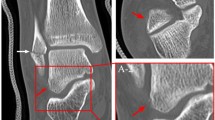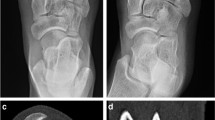Abstract
Purpose
Multi-detector computed tomography (MDCT) is superior in fracture detection than conventional radiography; however, dose is increased. Cone-beam computed tomography (CBCT) offers higher spatial resolution and lower dose than MDCT. Manufacturers offer an ultra-low-dose algorithm. This study compares the diagnostic accuracy of the ultra-low-dose CBCT (ULDCBCT) with that of the standard-dose CBCT (SDCBCT).
Materials and methods
In total, 64 patients were scanned with both the SDCBCT and the ULDCBCT protocols. Both studies were reported by two consultant radiologists with fellowship training in emergency radiology separated in time. The reporter recorded a diagnosis of fracture or normal and diagnostic confidence using a 5-point Likert scale. The gold standard was taken as the SDCBCT. Reporters were blinded to the indication and the SDCBCT report. Cases of discrepancy were resolved by consensus.
Results
There were 34 fractures and 30 cases had no fracture. Several fractures were missed using the UDCBCT, and there were also several cases of overdiagnosis. ULD was inferior to SD for fracture diagnosis (p < 0.00001). The diagnostic accuracy of ULDCBCT was 82.8% (75.1–88.9 CI). The diagnostic accuracy of plain radiograph was 64% (55.1–75.7% CI). Diagnostic confidence was reduced; the mean confidence for SDCBCT was 4.68 vs 4.12 for ULDCBCT (p < 0.001). The Kappa for interobserver agreement was 0.6.
Conclusion
ULDCBCT is inferior to SDCBCT in fracture detection and confidence is reduced. For diagnostic studies, the standard dose should be used.



Similar content being viewed by others
References
Weisel BB, Saunders RA, Weisel SW. Chapter 23: physical impairment ratings for fractures. In: Browner BD, Jupiter JB, Levine AM, Trafton PG, Krettek C, editors. Skeletal trauma: basic science, management, and reconstruction, 4th ed. Philadelphia: Elsevier; 2009.
Balci A, Basara I, Çekdemir EY, et al. Wrist fractures: sensitivity of radiography, prevalence, and patterns in MDCT. Emerg Radiol. 2015;22:251–6. https://doi.org/10.1007/s10140-014-1278-1.
Zbijewski W, De Jean P, Prakash P, Ding Y, Stayman JW, Packard N, et al. A dedicated cone-beam CT system for musculoskeletal extremities imaging: design, optimization, and initial performance characterization. Med Phys. 2011;38(8):4700–47136.
Hamie QM, Kobe AR, Mietzsch L, Manhart M, Puippe GD, Pfammatter T, Guggenberger R. Prototype metal artefact reduction algorithm in flat panel computed tomography-evaluation in patients undergoing transarterial hepatic radioembolisation. Eur Radiol. 2018;28(1):265–2737.
De Smet E, De Praeter G, te Verstrae KLA, Wouters K, DeBeuckeleer L, Vanhoenacker FMHM. Direct comparison of conventional radiography and cone-beam CT in small bone and joint trauma. Skeletal Radiol. 2015;44(8):1111–11178.
Posadzy M, Desimpel J, Vanhoenacker F. Cone beam CT of the musculoskeletal system: clinical applications. Insights Imaging. 2018;9(1):35–45. https://doi.org/10.1007/s13244-017-0582-1.
Huang AJ, Chang CY, Thomas BJ, MacMahon PJ, Palmer WE. Using cone-beam CT as a low-dose 3D imaging technique for the extremities: initial experience in 50 subjects. Skeletal Radiol. 2015;44(6):797–8099.
Edlund R, Skorpil M, Lapidus G, Bäcklund J. Cone-beamCT in diagnosis of scaphoid fractures. Skeletal Radiol. 2016;45(2):197–20410.
Neubauer J, Benndorf M, Ehritt-Braun C, Reising K, Yilmaz T, Klein C, Zajonc H, Kotter E, Langer M, Goerke SM. Comparison of the diagnostic accuracy of cone beam computed tomography and radiography for scaphoid fractures. Sci Rep. 2018;8(1):390611.
Welling RD, Jacobson JA, Jamadar DA, Chong S, Caoili EM, Jebson PJ. MDCT and radiography of wrist fractures: radio-graphic sensitivity and fracture patterns. AJR Am J Roentgenol. 2008;190(1):10–6.
Ludlow JB. Hand-wrist, knee, and foot-ankle dosimetry and image quality measurements of a novel extremity imaging unit providing CBCT and 2D imaging options. Med Phys. 2018;45(11):4955–63. https://doi.org/10.1002/mp.13198.
Gibney B, Smith M, Moughty A, Kavanagh EC, Hynes D, MacMahon PJ. Incorporating cone-beam CT into the diagnostic algorithm for suspected radiocarpal fractures: a new standard of care? AJR Am J Roentgenol. 2019;213(5):1117–23. https://doi.org/10.2214/AJR.19.21478.
Koivisto J, van Eijnatten M, et al. Effective radiation dose in the wrist resulting from a radiographic device, two CBCT devices and one MSCT device: a comparative study. Radiat Prot Dosimetry. 2018;179(1):58–68. https://doi.org/10.1093/rpd/ncx210.
Hart D, & Wall BF. Radiation exposure of the UK population from medical and dental X-ray examinations. Report NRPB W4. 2002.
Hart D, et al. Frequency and collective dose for medical and dental X-ray examinations in the UK, 2008. Report HPA-CRCE-012. 2008.
Biswas D, et al. Radiation exposure from musculoskeletal computerized tomographic scans. J Bone Joint Surg Am. 2009;91(8):1882–9. https://doi.org/10.2106/JBJS.H.01199.
ICRP. Recommendations of the International Commission on Radiological Protection. Publication 60. Annals of the ICRP, 21 Nos 1–3. 1990.
ICRP. Recommendations of the International Commission on Radiological Protection. Publication 103. Annals of the ICRP, 37 Nos 2–4. 2007.
Gibney B, Murphy MC, Ahern DP, et al. Trapezium fracture: a common clinical mimic of scaphoid fracture. Emerg Radiol. 2019;26:531–40. https://doi.org/10.1007/s10140-019-01702-2.
McHugh ML. Interrater reliability: the kappa statistic. Biochem Med (Zagreb). 2012;22(3):276–82.
Karl JW, Swart E, Strauch RJ. Diagnosis of occult scaphoid fractures: a cost-effectiveness analysis. J Bone Joint Surg Am. 2015;97(22):1860–8.
Yin ZG, Zhang JB, Gong KT. Cost-effectiveness of diagnostic strategies for suspected scaphoid fractures. J Orthop Trauma. 2015;29:e245–52.
De Zwart AD, Beeres FJP, Ring D, et al. MRI as a reference standard for suspected scaphoid fractures. Br J Radiol. 2012;85:1098–101.
Posadzy M, Desimpel J, Vanhoenacker F. Cone beam CT of the musculoskeletal system: clinical applications. Insights Imaging. 2018;9:35–45.
Faccioli N, Santi E, Foti G, Mansueto G, Corain M. Cost-effectiveness of introducing cone-beam computed tomography (CBCT) in the management of complex phalangeal fractures: economic simulation. Musculoskelet Surg. 2020. https://doi.org/10.1007/s12306-020-00687-3.
Prosser GH, Isbister ES. The presentation of scaphoid non-union. Injury. 2003;34:65–7.
Roolker W, Maas M, Broekhuizen AH. Diagnosis and treatment of scaphoid fractures: can non-union be prevented? Arch Orthop Trauma Surg. 1999;119:428–31.
Burns MJ, Aitken SA, McRae D, Duckworth AD, Gray A. The suspected scaphoid injury: resource implications in the absence of magnetic resonance imaging. Scott Med J. 2013;58:143–8.
O’Connor C, et al. Radiation doses received by the Irish population. Radiological Protection Institute of Ireland, special report. 2014.
Author information
Authors and Affiliations
Corresponding author
Ethics declarations
Ethical approval
All procedures performed in studies involving human participants were in accordance with the ethical standards of the institutional and/or national research committee and with the 1964 Helsinki declaration and its later amendments or comparable ethical standards.
Informed consent
Informed consent was obtained from all individual participants included in the study.
Additional information
Publisher’s note
Springer Nature remains neutral with regard to jurisdictional claims in published maps and institutional affiliations.
Rights and permissions
About this article
Cite this article
Murphy, M.C., Gibney, B., Walsh, J. et al. Ultra-low-dose cone-beam CT compared to standard dose in the assessment for acute fractures. Skeletal Radiol 51, 153–159 (2022). https://doi.org/10.1007/s00256-021-03825-5
Received:
Revised:
Accepted:
Published:
Issue Date:
DOI: https://doi.org/10.1007/s00256-021-03825-5




